History in Threads: Exploring Wayúu Mochilas
Between the tropic of Cancer and the tropic of Capricorn, in the land of magical realism, where the sun hides in mountains and two oceans, a culture survived the arrival of the Spanish and continued to preserve their traditions throughout the centuries.
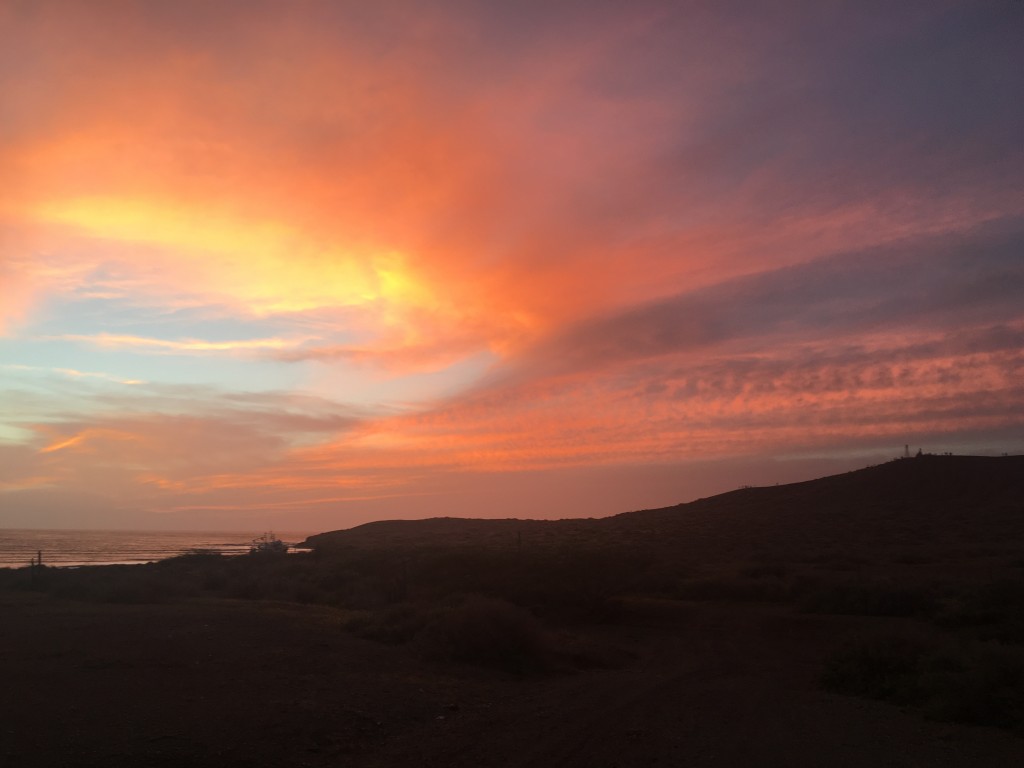
The Wayúu, a tribe located in northeast of Colombia, and the northwest of Venezuela, are the largest indigenous community in Colombia where they inhabit the region called La Guajira, enduring the harsh conditions of the semi-arid ecosystem. As a tribe, they are not subjected to political frontiers and are able to move freely between both countries, acting semi-nomadic. Never conquered by the Spanish, throughout the 17th century the Wayúu fought against the occupiers and became known as a fierce tribe. Their tenacity enabled them to preserve their traditions, especially through their language Wayuunaiki, which remains largely spoke although the newer generations speak both Wauunaiki and Spanish. As other indigenous tribes, the Wayúu have experienced discrimination and oblivion from the governments of Colombia and Venezuela, the first one only recognizing their presence and territory until the constitution of 1991. Wayúu are best known for the beautiful and colorful crochet textiles created by women. They even have a popular saying: “To be a woman is to know how to weave.”
They even have a popular saying: “To be a woman is to know how to weave.”
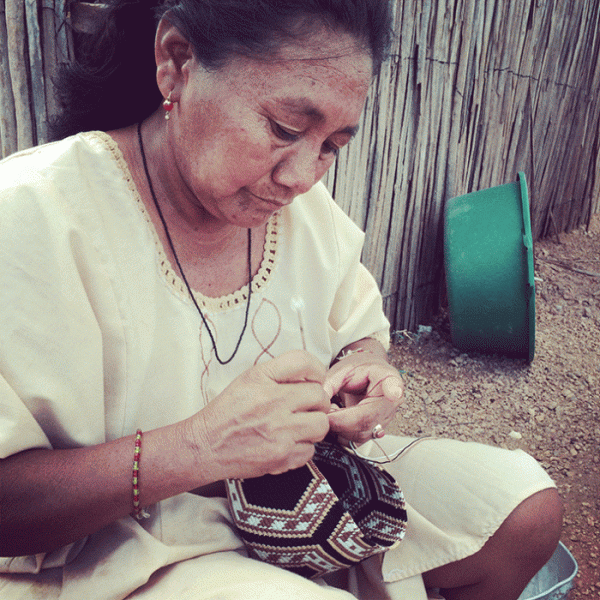
The most common woven creations are the mochilas, small bags, made of colorful yarn with intricate patterns and motifs. Through the motifs, the weaver shares their cosmological view of the universe, and their traditions. The techniques are passed from generation to generation of women, making it one of the primary traditional aspects of the tribe, included as a rite of passage. Mochilas, chinchorros (hammocks), and other woven creations, have become a means of economical income for Wayuu women who sell them to tourists or people outside their tribe. The mochilas have raised awareness of the tribe, as well as the critical conditions they face.
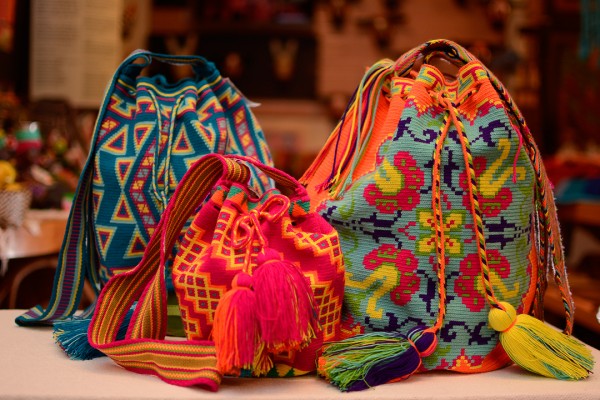
In recent years, Wayúu traditional bags have received great attention. You might have seen them in fashion magazines, blogs, becoming a fashion statement both in Colombia and internationally. Due to their popularity, various e-commerce sites have begun selling them, as well as stores around the world, raising questions about cultural appropriation and proper reimbursement for the weavers. Which raises the question: If anyone can wear them, can anyone make them?
Wayúu weavings are a symbol of tradition, that required people’s sacrifice to keep them alive. Does that entitle someone to create a tutorial or a how-to post to make your own mochila, and completely disregard the culture and history behind them? This research piece explores the traditions behind Wayúu bags, with the aim of bringing attention to the tribe’s history, and relate it to a broader debate between inspiration and appropriation from indigenous tribes.
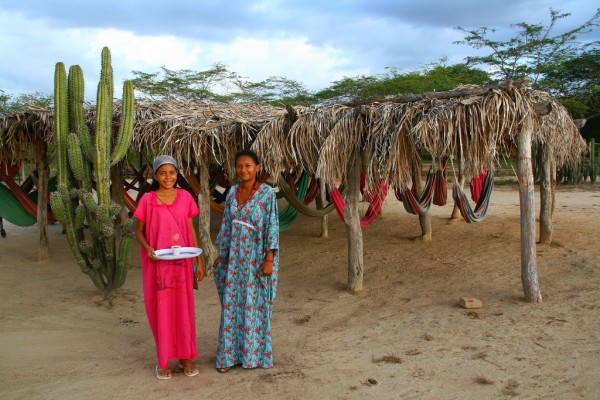
The Wayúu
Described as the people of the sea, wind, and soil, the Wayúu are part of the Arawak group, who were spread throughout South America and the Caribbean. The Wayúu used to be a nomadic tribe, moving from the Amazon rainforest and Antilles to the Guajira region around 3,000 years ago, where they currently occupy 4,170 square miles (10,800 square kilometers) within the desert covering a large area in both Colombia and Venezuela. They live in small, isolated settlements composed of 5 or 6 small houses called “rancherias” made from cactus or palm-leaf-tatched roofs, yotojoro (mud, hay or dried cane) walls with basic furniture. They sleep in hammocks (also called chinchorros) and cook in sauce pans that are usually hung from the ceiling. Within the rancherias they are able to preserve their traditions, and stay away from modern culture, while passing knowledge from generation to generation. Each community has their own government. Organized in matrilineal clans, the Wayúu children carry their mother’s last name, making women cultural and economical leaders for their clans. Besides textiles, Wayúu people also have their own crops and cattle, and goats.

Unfortunately, the Wayúu are one of the most endangered ethnic tribes. The harsh climate conditions, the exclusion from the government, and the contamination of their environment caused by the largest open coal mine in South America; have made their living situation extremely delicate. They have faced discrimination and exclusion from both the Colombian and Venezuelan governments, each taking away their rights, and raw material from the land without distributing equally the profits. The Wayúu live below the poverty line, facing hunger and sickness, struggling for survival every day. In the past, the communities survived through farming, and the coastal communities used to do pearl diving for aquaculture. However, commercialization has threatened their pearl diving, and the creation and spread of fraudulent pearls made the activity no longer profitable. Global warming and El Niño phenomenon have caused an ongoing drought for the past few years that has affected the Guajira region, making agriculture almost impossible for the Wayúu, as well as clean water for their consumption and to keep their animals. In 2011, in the efforts of providing clean water to nine municipalities, the government built the Cercado Dam that resulted in the drain of the Rancheria River, which used to be Wayúu’s only nearby water resource. Currently, Wayúu people have to walk for three hours in the middle of the desert to find wells that are often contaminated with salt and bacteria, causing sickness.
In 2015, Colombian media released a report conducted by La Defensoria del Pueblo (Colombian Ombudsman) denouncing the avoidable deaths of many Wayúu children due to malnourishment, as part of the economical, social, and environmental problem of La Guajira. According to La Asociación de Autoridades Tradicionales Indígenas Wayúu Shipía Wayuu, in the last 5 years 4.700 Wayúu children have died from malnutrition. Due to decline of their farming, Wayúus have to buy more and more to cover their basic needs, which currently outweigh their means. A decade ago, the tribe heavily relied on the subsidized groceries given by the Venezuelan government to survive and buy rice, sugar, and coffee, but due to the current crisis that the country is going through, the subsidiaries are no longer available. But malnutrition is sadly not the only problem that the communities have. In the past, men used to work with the land through agriculture and farming, but since this is no longer possible and most of them are highly uneducated and only speak their native language, the men have resorted into petty crimes, roadblockings, charging tourists candy taxes, children cutting school and men turning to alcohol. Some people consider the Wayuu tribe a deadweight for modern society, instead of valuing the history and traditions that they have preserved as part of Colombian and Venezuelan cultural heritage.
Nonetheless there are NGOs initiatives that aim to help the communities during these difficult times, when they need it the most. Some communities are also trying to find sustainable sources of income. For example the Uribia tribe is striving to use tourism in order to improve their living conditions. They are currently allowing visitors into their community and offering them an insight into their traditions and ways of living.
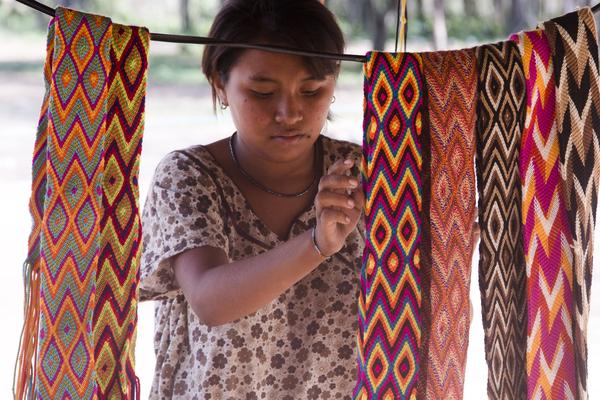
Wayúu and Textiles
According to Wayúu cosmology, everything on Earth is connected, and has a soul. In their language, Wayuunaiki, every vegetable, animal, human, or mineral has a soul and a language.
The Wayúu rely completely on their language as their traditions are transmitted orally from generation to generation, creating multiple versions of the myths and legends that explain their origins. Such is the case of the Waleker legend, the one that recounts the origins of spinning and weaving for the Wayúu. One of the versions describes how Irunúu, a guajiro hunter, met on his way home a handicapped girl named Wokoloonat, who out of compassion Irunúu took to his family home. However the rest of his family didn’t like Wokoloonat’s presence and didn’t treat her well when Irunúu wasn’t home. What none of them knew, was that Wokoloonat was a master weaver who every night, while the rest were sleeping, she would transform into a beautiful girl and manufactured beautiful weavings from colored threads she pulled from her mouth. One night the hunter discovered the beautiful woman creating the woven pieces, and when he told others, the beautiful woman became a spider and disappeared.
Another common legend, the weaving tradition comes from “Wale’kerü” a spider that taught women how to weave, and use the thread, colors, and patterns as a storytelling technique. Thus, each bag is unique to the weaver, and it is extremely unlikely to find a duplicate. Women learn to weave as part of their rite of passage, following a long standing tradition that’s central to Wayúu beliefs. When a girl gets her first menstruation, she begins an isolation period of 1 year (in Wayúu terms: 365 suns and 12 moons) with the purpose of leaving behind her childhood in order to become a woman, and ultimately a wife. During this time, only female family members or close women from the clan are allowed to see her. The rite begins with the girl laying down completely still in a chinchorro (hammock). After that she will be given a variety of drinks of traditional medicine that will make her sick in order to vomit. The Wayúu believe that this action represents the exit of the child spirit.
The second step of the rite consists in a series of baths, three during the day and one in the early morning before sunrise, as Wayúu believe that cold helps to draw out impurities. This step finalizes when a successful woman from the clan, meaning she has a good marriage, wealth and children, bathes the girl and cuts off all her hair. The remaining time that she stays isolated, her “women education” begins, where she receives all sorts of instructions to become the ideal woman for marriage, how to take care of a home, but most importantly how to weave. The more ability a woman shows in her woven creations, the more prestige she’ll have inside the clan.
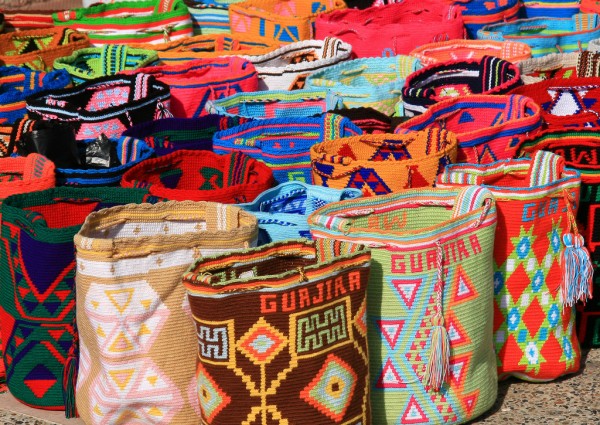
Mochilas
“Each Mochila bag requires our physical and emotional energy, we spend up to 25 days to weave a large bag and more than a month to weave a hammock. In each Kanas (patterns in Wayuunaiki) we portray our way of life and most of all our values and beliefs in the bags.” -Teresa, Wayúu member via The Fashion Revolution.
For the Wayúu, textiles are an art through which they can represent their feelings and hopes, making the textiles symbols of creativity, intelligence, wisdom, and status. There is a variety of mochila types, each designated for a particular use or user. The most common type is the Susu which translates to "everyday wear," it is used to carry personal items, tools for work, and in the case of women thread to work on their textiles. As the tribe struggles for survival, the mochilas have become one of their primary sources of income. Traditional mochilas can be described as medium-size bucket bags that can be woven/knitted single-threaded or double-threaded, and the strap is later attached. Wayúu women travel around the Guajira region tourist area to sell their bags in order to bring money and food for their families. Sometimes, a representative from the clan will gather all the bags produced in the community and take them to the cities to be sold.

Motifs
As it has been emphasized, Wayúu textiles are charged with meaning and symbolism, thus the motifs are a representation or interpretation of the Wayúu worldview. The symbols are called Kaanás, which translates to “the art of weaving drawings” which are constantly designs of animals, constellations, flowers, or objects present in their environment. The designs are characterized by geometric compositions, which are repeated in sequences creating patterns along the borders, as well as along the length and width of the pieces. The traditional Kaanás have names that are allusive to what they represent, here are some examples of them:
Kuliichiya: represents the dried wood used for the rancheria roofs.
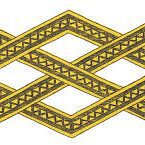
Antajirasü: represents the intersection of paths.

Siwottouya: allegory of the prints that a horse leaves.
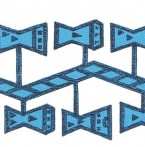
Mochilas around the world
Wayúu mochila bags have gained international spotlight due to initiatives like the Mochila Project launched by Moda Operandi, and lead by Vogue editor Lauren Santo Domingo in 2009. The project teamed up with 11 well-recognized designers who created their interpretation of the traditional bag, acting as a merge between indigenous craft, modern fashion technologies, and designer’s signature style. At a starting price of $5,000, the one-of-a-kind bags from the Mochila Project Collection were auctioned in Miami at the BeLive charity gala in November 2009, and the proceeds were donated to 30 charity organizations around Colombia. Here are some of the bags from the collection, if you want to see the entire collection, visit Purse Blog post on it.
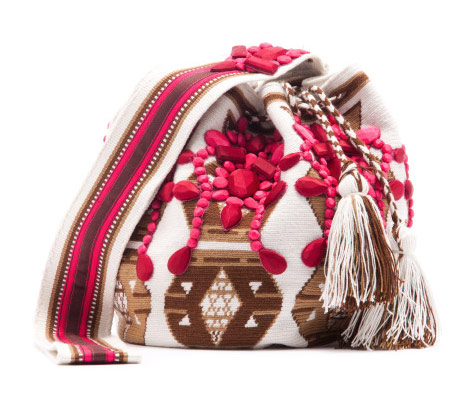
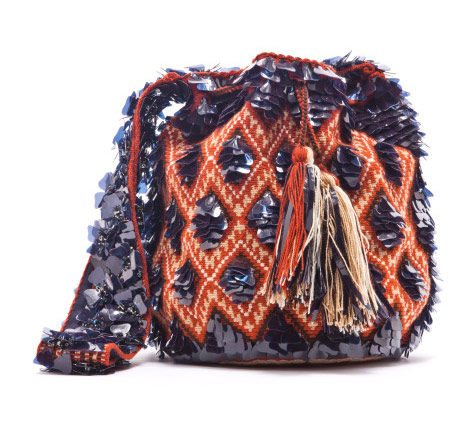
After the success and popularity of the Mochila Project, brands like J. Crew included Wayúu bags in their 2010 fall catalog, which most sold before they could even arrive to the stores. Jenna Lyons, J. Crew’s creative director at the time, considered that the bags’ popularity was due to their craftsmanship, declaring “craftsmanship is something rare and very valuable (...) There are few things that are still made by hand, much less in a technique that is handed down through generations and is a means of support for a community.” via The New York Times.
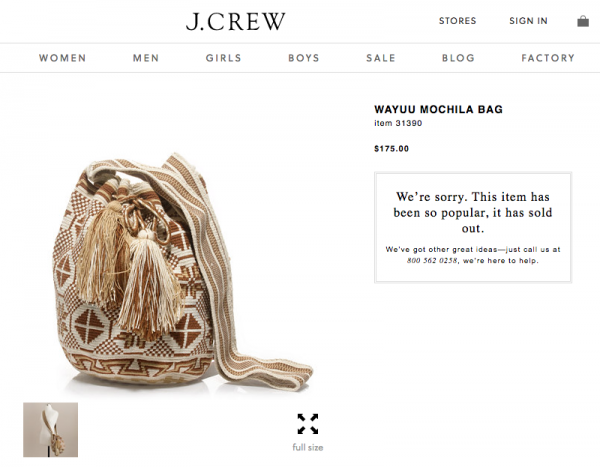
Colombian designer, Silvia Tcherassi, has been promoting Wayúu bags and craft for the past 9 years, acknowledging her responsibility as ambassador and promoter of Colombian talents around the world. In her stores and online retail, Tcherassi offers Wayúu mochilas through her style and aesthetic. Nowadays, it is fairly easy to purchase a Wayúu bag through various websites. Some e-commerce sites acknowledge the weavers and the culture behind the bags, and promise to donate a percentage of their profit to charity or NGOs who are helping Wayúu tribes. However, not all e-commerce sites are telling the Wayúu history or helping the community, and are just interested in the bags for their aesthetic qualities without respecting the traditions that they carry. On other sites, patterns and tutorials are offered to create your own Wayúu mochila, or etsy shops based in countries other than Colombia or Venezuela, are selling bags under the name of Wayúu even if the makers are not part of the tribe.
Another issue surrounding the commercialization of Wayúu mochilas is their price. If you purchase a bag in La Guajira, the price is around 30-50 dollars, however when you look at most e-commerce sites all prices start at 100 dollars. Of course you have to take into account shipping, taxes, and other additional costs, but for a bag that offers at least 70% rentability some of those profits should go back to La Guajira to help the Wayúu that truly need it.
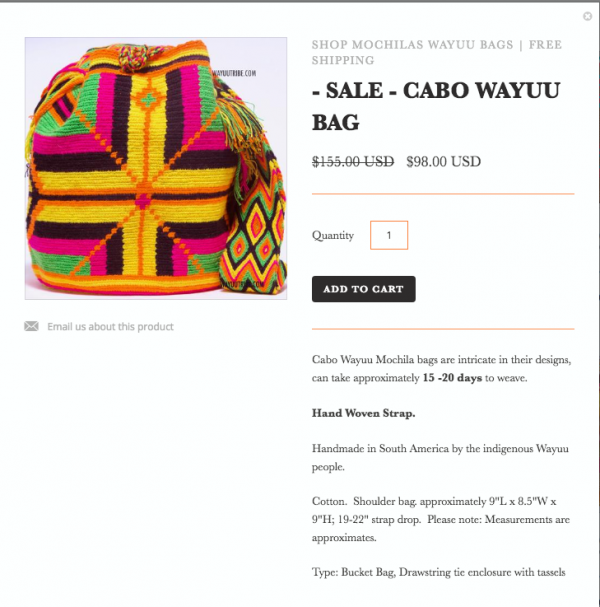
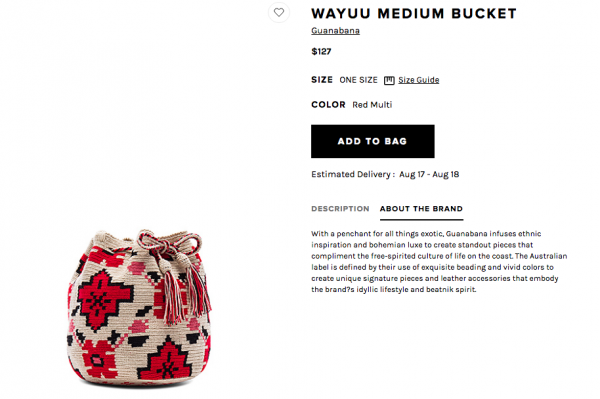
As previously mentioned, weaving for the Wayúu is more than a decorative object, they are cultural objects that transmit history and tradition, and for someone or a company to alienate them from their producers or history is considered appropriation, and even a violation of intellectual rights. In Colombia since 2011, the term “Wayúu” has been used as a denomination of origin, in order to protect the intellectual rights that belong to the indigenous artisans. Wayúu textile traditions are understood as cultural patrimony should remain acknowledged as such, respecting its origins. Calling a bag “Wayúu mochila” and not acknowledging the tradition it carries, is appropriation and taking advantage of a community that by itself doesn’t have the means to defend itself.
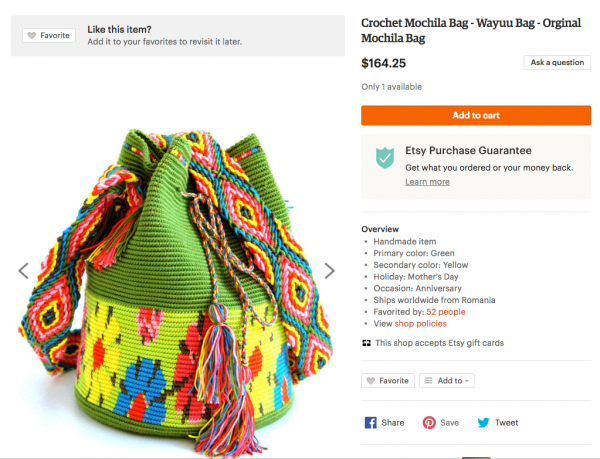
The root of the problem is not that the bags are being spread throughout the world, it is when the bags are detached from the people who made them and the traditions that are carried through them. This situation related to a broader conversation of the debate of inspiration vs. plagiarism, and proper reimbursement for the makers.
This is a delicate subject, that has affected various indigenous tribes around the world. In 2015, French designer Isabel Marant was put under the scope when one of her blouses bore great resemblance, almost identical, to the traditional blouses worn by Mixe women of Santa Maria Tlahuitoltepec, in the Mexican state of Oaxaca. The issue got more complicated, when a rumor was spread saying that Marant was fighting another company for the copyrights of the Tlahuitoltepec's blouses. Even though Marant released a statement denying the rumors, the cultural appropriation is still there, and like in the Wayúu case the margin of profit is very different.
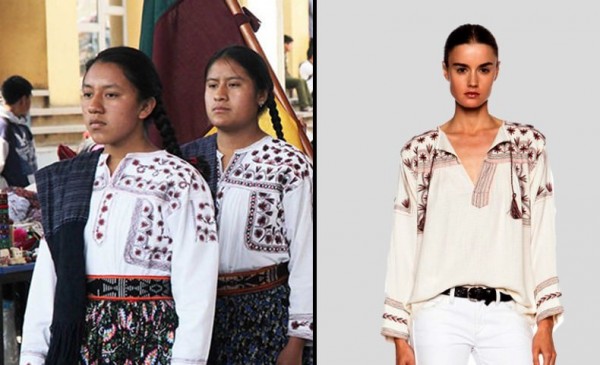
In a globalized world, where cultural barriers are constantly shifted, and exposure to traditions from the other sides of the world are more and more accessible, it is great that people around the world are becoming familiar with the work of indigenous tribes, and appreciate their work. However, it is absolutely necessary to have a respectful attitude towards their work, and make the effort to view it with the same importance that the makers see them. It is important to be a responsible consumer, especially when dealing with objects that are part of an indigenous culture, and in this case a tribe that is endangered and truly needs the profits of any mochila sales. As Jenni Avins said in an article for Quartz, “Treat cultural exchange like any other creative collaboration–give credit, and consider royalties.”
I hope this article helped shed some light into the mystical and colorful world of the Wayúu, and provides some understanding of their craft and the tradition they carry.
References
Artesanias de Colombia:
http://www.artesaniasdecolombia.com.co/PortalAC/C_noticias/la-mochila-wayu-parte-de-la-tradicion-de-colombia_5070
Davies, Lucy. "Arts and Crafts of South America." San Francisco: Chronicle Books, 1995.
El Espectador: http://www.elespectador.com/noticias/nacional/el-exterminio-del-pueblo-wayuu-articulo-555826
Fashion Revolution: http://fashionrevolution.org/the-human-face-of-the-wayuu-mochila-bags/
Motalas: http://motalasblog.blogspot.com/2014/07/significado-y-simbolos-de-la-mochila-wayuu.html
University of Illinois:
https://publish.illinois.edu/iaslibrary/2016/04/13/crimes-of-fashion/
Wark, Mirja. "Si'ira: La Apreciada Faja Tejida de los Indios Wayúu de la Guajira, en el límite Septentrional entre Venezuela y Colombia." Groningen: Editorial Yanama, 2005.
Wayúu Made: http://www.wayuumade.com/wayuu-people/
Wayúu Tribe: https://wayuutribe.com/collections/wayuu-bags-cabo-mochilas